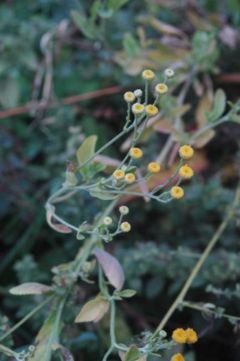Tanacetum balsamita: Difference between revisions
No edit summary |
No edit summary |
||
| Line 1: | Line 1: | ||
{{SPlantbox | |||
|familia=Asteraceae | |||
|genus=Tanacetum | |||
|species=balsamita | |||
|common_name=Alecost,�Costmary | |||
|Min ht box=36 | |||
|Min ht metric=in | |||
|Min wd box=18 | |||
|Min wd metric=in | |||
|lifespan=perennial | |||
|exposure=sun | |||
|flower_season=early summer, mid summer, late summer, early fall, mid fall, late fall | |||
|flowers=white | |||
|Temp Metric=°F | |||
|min_zone=6 | |||
|max_zone=10 | |||
|jumpin=If this plant info box on watering; zones; height; etc. is mostly empty you can click on the edit tab and fill in the blanks! | |||
|image=Upload.png | |||
|image_width=240 | |||
}} | |||
{{Taxobox | {{Taxobox | ||
| color = lightgreen | | color = lightgreen | ||
Revision as of 11:41, 15 April 2010
| Tanacetum balsamita subsp. var. | Alecost, �CostmaryProperty "Common name" (as page type) with input value "�Costmary" contains invalid characters or is incomplete and therefore can cause unexpected results during a query or annotation process. | |||||||||||||||||||||||||||||||||||||||||||||||||||||||
|---|---|---|---|---|---|---|---|---|---|---|---|---|---|---|---|---|---|---|---|---|---|---|---|---|---|---|---|---|---|---|---|---|---|---|---|---|---|---|---|---|---|---|---|---|---|---|---|---|---|---|---|---|---|---|---|---|

|
|
| ||||||||||||||||||||||||||||||||||||||||||||||||||||||
| ||||||||||||||||||||||||||||||||||||||||||||||||||||||||
| Costmary {{{status}}} Fossil range: {{{fossil_range}}}
| ||||||||||||||||||||||||||||||||||||||||||||||||||||||||||||||||||
|---|---|---|---|---|---|---|---|---|---|---|---|---|---|---|---|---|---|---|---|---|---|---|---|---|---|---|---|---|---|---|---|---|---|---|---|---|---|---|---|---|---|---|---|---|---|---|---|---|---|---|---|---|---|---|---|---|---|---|---|---|---|---|---|---|---|---|
 | ||||||||||||||||||||||||||||||||||||||||||||||||||||||||||||||||||
| Plant Info | ||||||||||||||||||||||||||||||||||||||||||||||||||||||||||||||||||
| ||||||||||||||||||||||||||||||||||||||||||||||||||||||||||||||||||
| Scientific classification | ||||||||||||||||||||||||||||||||||||||||||||||||||||||||||||||||||
| ||||||||||||||||||||||||||||||||||||||||||||||||||||||||||||||||||
| [[{{{diversity_link}}}|Diversity]] | ||||||||||||||||||||||||||||||||||||||||||||||||||||||||||||||||||
| {{{diversity}}} | ||||||||||||||||||||||||||||||||||||||||||||||||||||||||||||||||||
| Binomial name | ||||||||||||||||||||||||||||||||||||||||||||||||||||||||||||||||||
| Tanacetum balsamita L. | ||||||||||||||||||||||||||||||||||||||||||||||||||||||||||||||||||
| Trinomial name | ||||||||||||||||||||||||||||||||||||||||||||||||||||||||||||||||||
| {{{trinomial}}} | ||||||||||||||||||||||||||||||||||||||||||||||||||||||||||||||||||
| Type Species | ||||||||||||||||||||||||||||||||||||||||||||||||||||||||||||||||||
| {{{type_species}}} | ||||||||||||||||||||||||||||||||||||||||||||||||||||||||||||||||||
| {{{subdivision_ranks}}} | ||||||||||||||||||||||||||||||||||||||||||||||||||||||||||||||||||
| [[Image:{{{range_map}}}|{{{range_map_width}}}|]] | ||||||||||||||||||||||||||||||||||||||||||||||||||||||||||||||||||
| Synonyms | ||||||||||||||||||||||||||||||||||||||||||||||||||||||||||||||||||
| {{{synonyms}}} |
Tanacetum balsamita is a perennial temperate herb known as Costmary, Alecost or Balsam herb.
It has been grown for many centuries for its pleasant, slightly medicinal or balsamic smell. It was used in medieval times as a place marker in bibles. It is referred to by Culpeper and others as the 'Balsam Herb'. [1] Leaves of the plant have been found to contain a range of essential oils. A Spanish study found the oil includes carvone as the main component (51.5%, 41.0% and 56.9% in three samples), together with minor amounts of beta-thujone, t-dihydrocarvone, c-dihydrocarvone, dihydrocarveol isomer c-carveol and t-carveol. It is noteworthy that levels of beta-thujone, a toxic ketone, were 9.8%, 12.5% and 12.1% in the respective samples. [2]
The plant is known from ancient herbals and was widely grown in Elizabethan knot gardens.
Nicholas Culpeper says of Costmary [3]
- It is under the dominion of Jupiter. The ordinary costmary, as well as maudlin, provokes urine abundantly, and softens the hardness of the mother; it gently purgeth choler and phlegm, extenuating that which is gross, and cutting that which is tough and glutinous, cleanseth that which is foul, and prevents putrefaction ; it openeth obstructions and relieves their bad effects, and it is beneficial in all sorts of dry agues. It is astringent to the stomach, and strengtheneth the livers other viscera : and taken in whey, worketh more effectively. Taken fasting in the morning, it relieves chronic pains in the head, and to stay, dry up, and consume all their rheums or distillations from the head into the stomach, a much to digest raw humours gathered therein, It is profitable for those that are fallen into a continual evil disposition of the body, called cachexy, especially in beginning of the disease. It is good for weak and cold livers. The seed is given to children for worms, and so is the infusion of flowers in white wine, about two ounces at a time. It maketh an excellent salve to heal old ulcers, being boiled with oil of olive, and adder's tongue with it; and after is strained, put in a little wax, rosin, and turpentine to make it as thick as required.
See also
References
- Culpepers British Herbal - Pub. William Nicholson and Son - C. 1905 (re-print of the 1653 original)